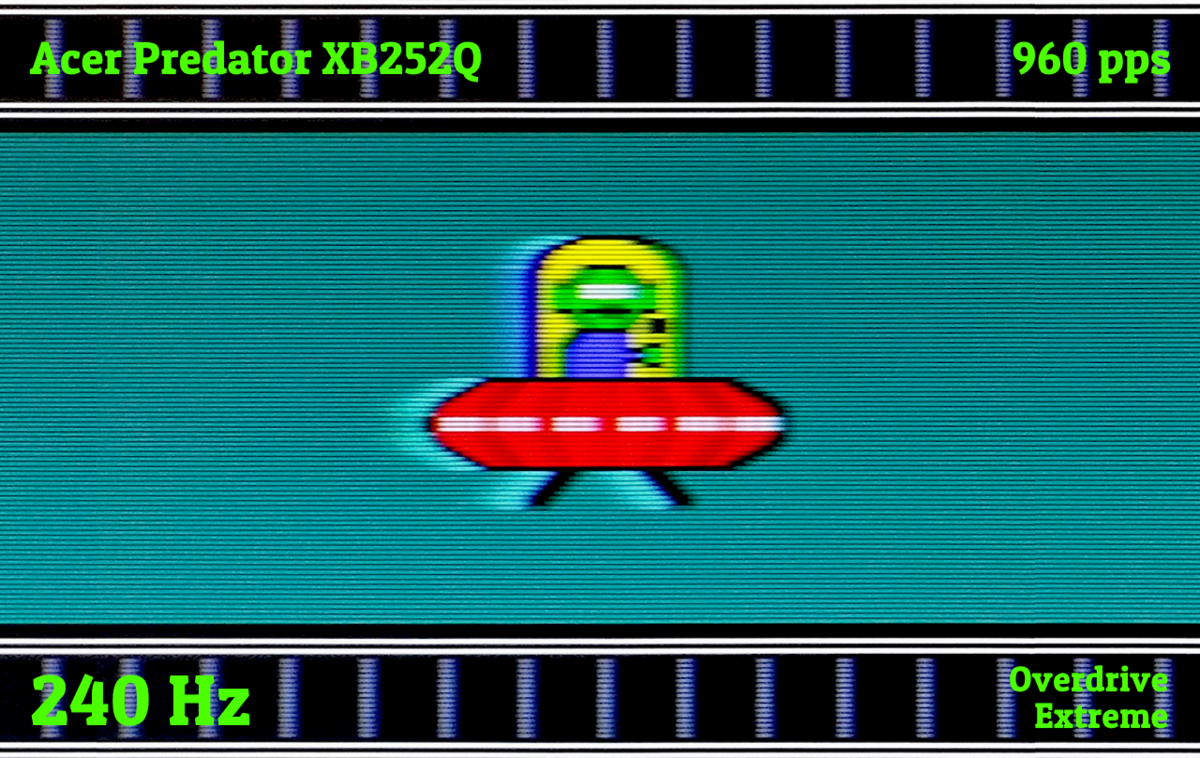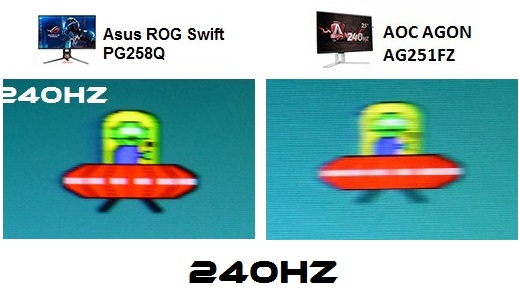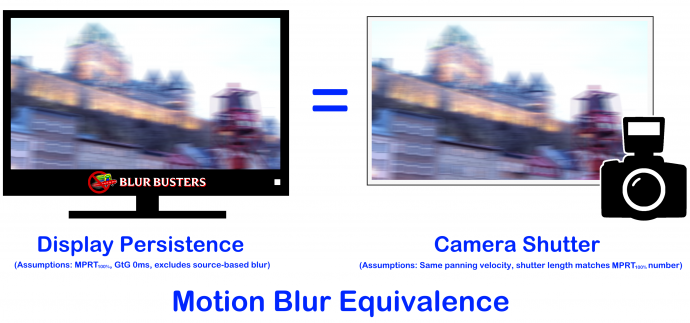Chief Blur Buster wrote: ↑20 Apr 2020, 20:26
forii wrote: ↑20 Apr 2020, 13:07
Hard to say, for me its hard to see 0,0008 second difference, but dunno how the response time matters in competive games.
One doesn't have to see the millisecond to win by the millisecond. There are many reasons the millisecond matters without being seen:
-- Motion blur effects. 1ms translates to 1 pixel per 1000 pixels/sec. You see this stuff in my multiple Area51 articles.
blurbusters.com/area51.
-- Race-to-finish effects. Just like Olympics 100 meter sprints -- 2 players turn a corner in a game, see each other the same time, shoot at same time. The bullet that hits first will win the frag for that.
-- There are other reasons the millisecond matters.
Even with 128tick servers (8ms granularity) 1ms sooner means 1/8th chance you've got the earlier server tick and got the frag score in a simultaneous-shoot situation. Mind you, Internet latency is a bigger factor, but if it's a LAN game or FTTH with locals, the statistical noise can matter to the people who earn hundreds of thousands of dollars playing esports. The Olympics "cross finish" effect doesn't have to be felt to be won.
There are some variables like 4000 pixels/sec fps=Hz strobing where 0.25ms MPRT versus 0.5ms MPRT actually become human visible. If you have an adjustable-MPRT monitor (NVIDIA "ULMB Pulse Width", BenQ "Strobe Pulse Duty", ViewSonic "PureXP Levels" (March 2020+ firmwares)) please view
TestUFO Panning Map Test at 3000 pixels/sec -- Google street labels 6-point text are unreadable at 1.0ms MPRT at 3000pixels/sec. You need 0.5ms MPRT to read those. And even 0.25ms vs 0.5ms MPRT becomes human visible! That's why Valve Index VR headset has achieved 0.3ms MPRT, since motion blur is even more important in virtual reality.
forii wrote: ↑20 Apr 2020, 13:07
Does the person who was 1ms response time see enemies faster jumping behind the wall, than a person who has a panel with 4ms??
1ms vs 4ms? That is already human visible in more ghosting/coronas (non-strobed) and massively more motion blur (strobed).

Check out
Making Of: Why Are TestUFO Display Motion Tests 960 Pixels Per Second?. One big one is because 960 is the closest number to 1000 that is evenly divisible by common refresh rates (60Hz, 120Hz, 240Hz). And now you are getting where I am getting -- 1 pixelwidth in the above image is 1 millisecond! So, 1ms vs 4ms can sometimes create 4x horizontally thicker ghosting effects. 1ms )(GtG90%) sometimes translates to 10ms (GtG100%) completeness, and 4ms (GtG90%) sometimes translates to 40ms completeness (GtG100%). It's not always the case, but this can happen very often with certain panels (at least for apples-vs-apples comparison, TN vs TN, IPS vs IPS, as the difference between GtG90% vs GtG100% is amplified on certain panels (dim colors on VA for example). Not sure of GtG 90% versus GtG 100%? See
Pixel Response FAQ: GtG Versus MPRT. And yes, for both GtG and/or MPRT, the stuff below 10% and above 90% is still human visible. These are just electronic measurement cutoff points.
forii wrote: ↑20 Apr 2020, 13:07
Is response time the most important thing of monitors?
Depends. And depends on what you need it to do. Millisecond lag? Millisecond GtG? Milliseconds MPRT? Win games? See clearer? Better motion? Less ghosting? Etc etc. The millisecond doesn't matter sometimes but matters at other times.
They are still able to become human visible to many who have the ability to see ghosting/corona artifacts. While not everyone sees the same, it is undeniable that milliseconds have gained amplified visibility due to the Vicious Cycle Effect (see section "Vicious Cycle Effect" in the
1000 Hz Journey Article with scientific animations and demos).
Higher resolutions, higher refresh rates, bigger panel sizes, fast motions, all amplify visibility of the millisecond in the GtG context and the MPRT contexts.
forii wrote: ↑20 Apr 2020, 13:07
For me most important is motion blur. Because I play dynamic games, when enemies are running, jumping behind the wall etc
If you use strobed modes, then get familiar with how MPRT 0.25ms vs MPRT 0.5ms vs MPRT 1.0ms actually becomes human-visible for fine-text during fps=Hz ultraspeed motion. At 4000 pixels/second, 0.25ms equals 1 pixel, 0.5ms equals 2 pixels, 1ms equals 4 pixels.
forii wrote: ↑20 Apr 2020, 13:07
Also for me response time is marketing, and everything bellow 5ms is perfect for fast shooters.The most important is the blurry and motion clarity, which is pretty fine on the asus with 280Hz, thats why 240hz ips panels are nice for gaming, compare to 144hz IPS - these can be blurry compare to 144hz TN.
Higher refresh rates reduce the MPRT without needing strobing, because MPRT is proportional to pixel visibility time, which naturally means:
MPRT of nonstrobed = length of refresh cycle
MPRT of strobed = length of strobe pulse
So people who hate strobing, but wants less motion blur (lower MPRT)
240Hz = 1/240sec MPRT(100%) excluding bottlenecks from GtG
280Hz = 1/280sec MPRT(100%) excluding bottlenecks from GtG
At these refresh rate stratospheres, it's harder to reduce motion blur with small Hz jumps. You need to jump up Hz a lot more to see human-visible benefits. That's why Blur Busters is an advocate of the geometric curve, 60Hz -> 120Hz -> 240Hz -> 480Hz -> 960Hz.
forii wrote: ↑20 Apr 2020, 13:07
240hz IPS vs 144hz TN is pretty similar with motion blur.
That can happen when GtG adds to the MPRT.
When adjusting overdrive to something that is balanced (no objectionable overshoot artifact).
1/240sec + 5ms no-overshoot GtG = about 9ms of combined smear (persistence blurring + GtG ghosting combined)
1/144sec + 3ms no-overshoot GtG = about 10ms of combined smear (persistence blurring + GtG ghosting combined)
So it's true that slow 240Hz can match a fast 144Hz. I've seen that happen.
This is an ultra-simplistic point of view, but this is exactly why we don't like small refresh rate jumps, e.g. 144Hz vs 165Hz -- that difference is less visible than 240Hz vs 360Hz to my eyes! (I've seen the 360Hz TN monitor, by the way -- no IPS can beat that -- and I'm also reminding RLSContender to respect TN too).
Also, there's been some easter egg tweaks that's been happening. ViewSonic XG270 running at 224Hz (at max overdrive, which doesn't overshoot visibly at 224Hz) actually looks clearer than 240Hz, and competitive with many 240Hz TN panels. More noticeable difference versus 144Hz, because the optimized non-overshoot GtG is much faster at 224Hz than at 240Hz. So there are additional surprising variables too, since
GtG are simply metaphorical soccer balls which occasionally explains why GtG sometimes speeds up with certain sweet-spot refresh rates slightly below max-Hz -- trying to kick pixels more frequently (i.e. higher Hz) sometimes creates slower kicks for them (i.e. slower GtG) because the electronics doesn't have as much time to give the pixel a powerful running-start voltage "kick" per pixel in refreshing the pixel.
forii wrote: ↑20 Apr 2020, 13:07
240hz TN has better motion blur. than 240hz ips..
I agree for best TN panels.
That said....those older 240Hz TN monitors like the first 240Hz monitors from from 2016 -- such as the first AOC AF251FZ had a bit more blur than 1ms IPS. It was pretty impressive how 240Hz TN can vary a bit over 2016 through 2020. I expect XL2546S to be rather good, since it's non overdriven GtG will probably be even faster -- it's quite useful.
Here's an example of how much it can vary -- TFTCentral example

forii wrote: ↑20 Apr 2020, 13:07
but you can get used to this, because its not that much blurry on 240hz ips, that you can't see the parts enemy (head, eyes, etc).
240Hz IPS is quite good, when well adjusted. Definitely better than the worst TNs.
The venn diagram is now overlapping these days. The best TN can outperform the best IPS but the best 240Hz IPS now outperforms the worst 240Hz TN.
forii wrote: ↑20 Apr 2020, 13:07
If you like clear visibility, best motion blur you can turn ELMB and you will be for sure happy, but imo 240hz is enough, I play at 280hz (lesss lagier and much clear visibility) and im smashing every server, and being top1 in Cod Mw with top kills and score.
Indeed, 240Hz vs 280Hz may be subtle but it's not zero. I saw a more noticable difference for 240Hz vs 360Hz so I am looking forward to 360Hz. I prefer at least 1.5x jumps in refresh rates, preferably 2x, but it's hard to push the envelope faster at these stratospheres in the refresh race to retina refresh rates.
forii wrote: ↑20 Apr 2020, 13:07
Ah and also asus has very good input lag. the lowest of all monitors
It's impressive how low lag many of the 240Hz+ 1ms IPS panels are now. I think esports are about to discover them too. TN 360Hz will probably put another challenge though.




